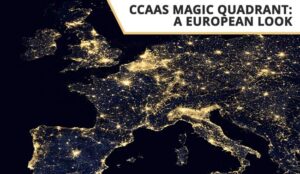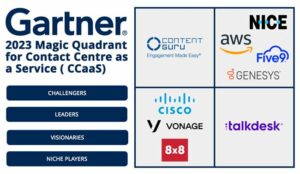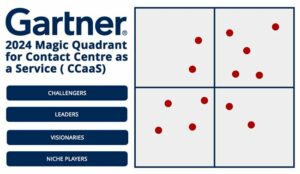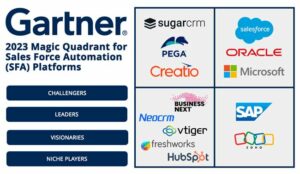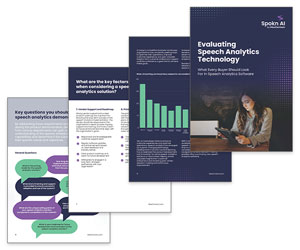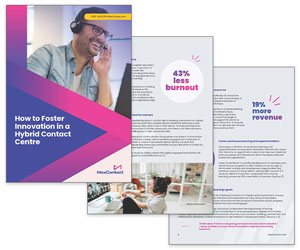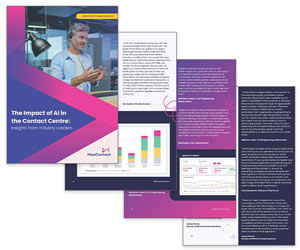As the new Gartner Magic Square (MQ) for Contact Centre as a Service (CCaaS) was released for 2024, this recent observation from Jonty Pearce, Founder of Call Centre Helper magazine, really got us thinking “Why aren’t these European providers represented in Gartner’s MQ for CCaaS?” Because the issue goes beyond a few missing names!
While the Magic Quadrant remains a respected tool for evaluating top technology vendors, it falls short in capturing the full landscape of regional players who excel in Europe in particular.
To find out why, we’ve dived deeper into the limitations of the Magic Quadrant for European organizations, looking at what’s potentially missing, and why it matters for businesses on this side of the Atlantic.
Is the Gartner Magic Quadrant Losing Its Relevance?
The Gartner Magic Quadrant is a widely recognized tool for evaluating technology vendors, providing a visual representation of the competitive landscape by categorizing key players into Leaders, Challengers, Visionaries, and Niche Players.
Historically it has helped to identify emerging trends and technologies and has helped businesses make informed decisions about which vendors to partner with. However, some believe it’s lost its relevance.
“The MQ seems to have lost its relevance. This is not to take away from the great brands recognized, but the speed of innovation and brands not captured demonstrates clearly that the MQ is no longer reflective of the market.” – Michael Clark, Contact Centre & Technology Leader
There’s also some debate that Gartner’s Magic Quadrant struggles to keep up with the speed of innovation, as much of the expert sentiment suggests that by the time the report is published, newer or smaller vendors with promising innovations might already be gaining traction, but then aren’t included in the Magic Quadrant due to Gartner’s more conservative inclusion criteria.
The rapid pace often outpaces the Quadrant’s evaluation cycles. Additionally, the focus on global market presence can sometimes overlook regional strengths and specific needs.
Across Europe, Gartner’s Stringent Inclusion Criteria Can Exclude Smaller, Innovative Players With Strong Local Market Relevance but Limited Global Reach
One of the Magic Quadrant’s limitations lies in its broad-brush approach, which can sometimes miss the nuances and unique needs of regional markets.
This is especially apparent in Europe, where Gartner’s stringent inclusion criteria – such as a high revenue threshold (recently raised from $60M to $72M) and a requirement for a presence across major global regions – can exclude smaller, innovative players with strong local market relevance but limited global reach.
As Nicolas de Kouchkovsky, CMO turned Industry Analyst, comments:
“The placement of Amazon Web Services (AWS), Five9, Genesys, and NICE in the top right quadrant aligns with market realities.
However, Gartner requires at least 50% of CCaaS service revenue to come from inbound voice licences. It’s time to lower this threshold to welcome new players from the digital and CRM arenas.”
And it’s not just revenue that excludes key players in the market, as Ben Booth, CEO and Co-Founder at MaxContact, explains:
“I used to think it was a “pay to play” model, and though there is a high cost of entry, even if we were willing to pay, the participation criteria are so high they rule out EU vendors.
I would be an advocate for breaking CCaaS vendors up into regions or doing something that allows for greater impartiality and inclusion of the market space in general.”
There Are Critical Elements That Fall Short of Addressing Europe’s Complex Regulatory Requirements and Customer Engagement Models
For many European businesses, the absence of regional CCaaS vendors in the MQ means they may miss solutions tailored to their specific needs.
European organizations often require vendors that can navigate strict data privacy regulations, cater to diverse language needs, and understand the varying customer expectations unique to different countries across the continent.
These are critical elements that can be overlooked by large, US-centric vendors who may meet the technical standards Gartner evaluates but fall short of addressing Europe’s complex regulatory requirements and customer engagement models.
This is believed to put European CCaaS providers at a disadvantage, and inadvertently sidelines reputable, high-quality vendors, as Pierce Buckley of Babelforce shares:
“What’s missing in the CCaaS Magic Quadrant this year is more important than what’s present!
You can see a pretty substantial US bias with very little of the EU perspective represented. Several of the companies listed in this year’s Magic Quadrant are adding very few customers in large parts of Europe.”
That’s why many key players in Europe advise companies to assess a wider array of vendors with region-specific strengths that are often overlooked in global reports like the Magic Quadrant, as David Mason, Director of Service and Operations UK and Ireland (Odigo), comments:
“The CCaaS market is vast, and selecting the right technology provider is crucial for organizations. As a leading European provider of CCaaS solutions, Odigo is proud of our continued excellence in meeting the diverse needs of end-users across Europe.
Our commitment to innovation, data privacy, and exceptional customer experiences positions us as a key player in the continent.
For businesses looking to enhance their customer service strategies, we encourage considering a diverse range of vendors to find the best fit for their unique requirements.”
At One Point There Was a CCaaS Magic Quadrant for Western Europe – But It Got Merged Into a Single Global CCaaS MQ
However, it’s not always been this way. Reflecting on the history of Gartner to date, Nerys Corfield explains how there once was more focus on Europe and why there’s now a single global report:
“In 1979, Gideon Gartner, a renowned philanthropist, founded what would become one of the world’s largest technology research firms – Gartner.
Generating $4.9 billion annually from research services, Gartner is best known for producing its Magic Quadrants (MQs), where technology vendors across over 100 categories are assessed and positioned within four squares.
In 2015, reflecting the anticipated shift for contact centre technology buyers from on-premise solutions to cloud-hosted software, Gartner transitioned from a Contact Centre Infrastructure MQ to a Contact Centre as a Service (CCaaS) MQ.
For the first five years, the handful of analysts dedicated to evaluating CCaaS vendors produced separate MQs for Western Europe and North America.
However, in 2020, acknowledging the globalized nature of software as a service, these reports were merged into a single Global CCaaS MQ. So now, despite there being an estimated 300 contact centre technology vendors globally, as of 2024, only nine CCaaS vendors meet Gartner’s criteria for inclusion – with just one based in Europe.”
One of the Significant Qualification Requirements Is Having Physical Resources in at Least Three Global Territories
Gartner’s influence on the revenue potential of vendors and the direction of the market is substantial, as Nerys continues:
“Vendors will move mountains, or more specifically – continents, to meet the entry requirements influenced by Gartner’s criteria and shaped by enterprise user feedback.
One of the significant qualification requirements is having physical resources in at least three global territories. Over the last few years we have seen US brands try to ‘break Europe.’
However, these companies have often been unprepared for Europe’s complex cultural and regulatory landscape and the need for software to be delivered in its 24 official languages. The competency curve has been steep, and some are still relatively perplexed at trying to customize a global product to meet regional needs.
How well does Gartner represent the needs of European buyers? Gartner operates in over 90 countries, with 9,514 (32%) of its employees spread across 89 countries outside the US. 66% of its revenue comes from the US, and only one of the five analysts named as contributors to the CCaaS MQ is based outside the US, in India.”
Reducing a Contact Centre’s Complexity to Four Quadrants Does Not Reflect the Intricacies of the Purchasing Decisions or the Wide Array of Vendors Available
This raises questions about how representative their understanding of European contact centre buyers truly is, as Nerys continues:
“Contact centres are complex, and after 26 years of working in, with, or for about 200 centres, I believe that reducing their complexity to four quadrants with nine static dots does not reflect the intricacies of the purchasing decisions or the wide array of vendors available to meet varying needs.
Gartner have finite resources managing significant numbers of user and vendor requirements. Their processes seem robust and considered, but it should not be seen as the definitive answer.
Today, if I were buying a washing machine, I wouldn’t subscribe to Which? (despite its proven objectivity through avoiding commercial relationships with the brands it evaluates).
The landscape has evolved. Open-source insights are increasingly accessible, and the CX vendor tapestry is more layered than many CCaaS providers would care to admit.
Global European enterprise buyers will continue to look to Gartner to facilitate approval at the C-Suite level, but the average European contact centre should scrutinize the requirements for securing a dot and decide if those criteria align with their specific needs. While the vendors featured in the MQ have merit, many others do as well.”
The Magic Quadrant Is Just One of Several Evaluation Tools
So how should buyers utilize the insights from the latest Gartner Magic Quadrant?
The Gartner MQ remains a valuable tool, but it’s essential for European businesses to approach it with a discerning eye. With its current focus on global market presence, the MQ might overlook European vendors whose offerings are highly suited to the local market.
By exploring a wider range of vendors and using the MQ as just one of several evaluation tools, European businesses can better position themselves to discover business solutions that meet both their technological and regional needs.
As the industry continues to evolve, a more inclusive approach to evaluating CCaaS providers may also be necessary to keep pace with regional requirements and rapid innovation. Until then, the best approach is to use the MQ as a starting point, but look beyond its limitations to find the right partners who truly understand and cater to the European market.
If you are looking for more information on technology vendors and industry reports, read these articles next:
- Gartner Releases Magic Quadrant for CCaaS 2024
- Have You Seen the Gartner 2023 Magic Quadrant for SFA?
- Ventana 2023 Buyers Guide for Contact Centre Suites Released
- The Top CCaaS Vendors for 2023/2024
- Gartner Magic Quadrant for CCaaS 2023
Author: Robyn Coppell
Reviewed by: Megan Jones
Published On: 19th Nov 2024 - Last modified: 16th Dec 2024
Read more about - Technology, babelforce, Ben Booth, CCaaS, David Mason, MaxContact, Nerys Corfield, Odigo, Pierce Buckley





